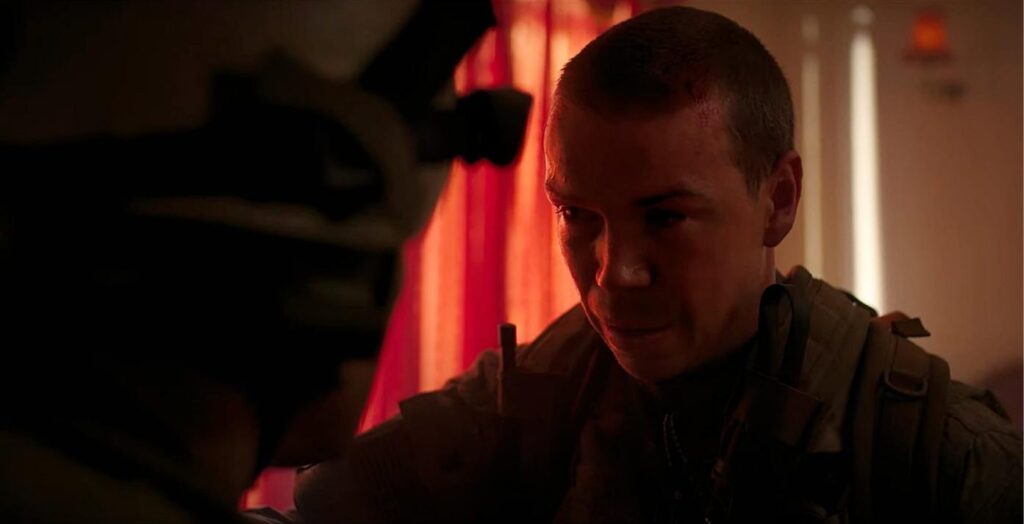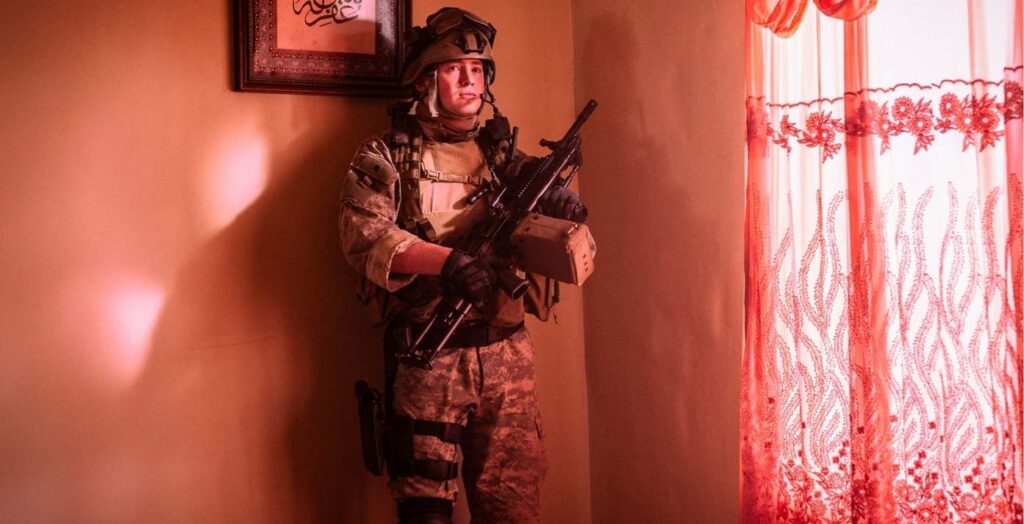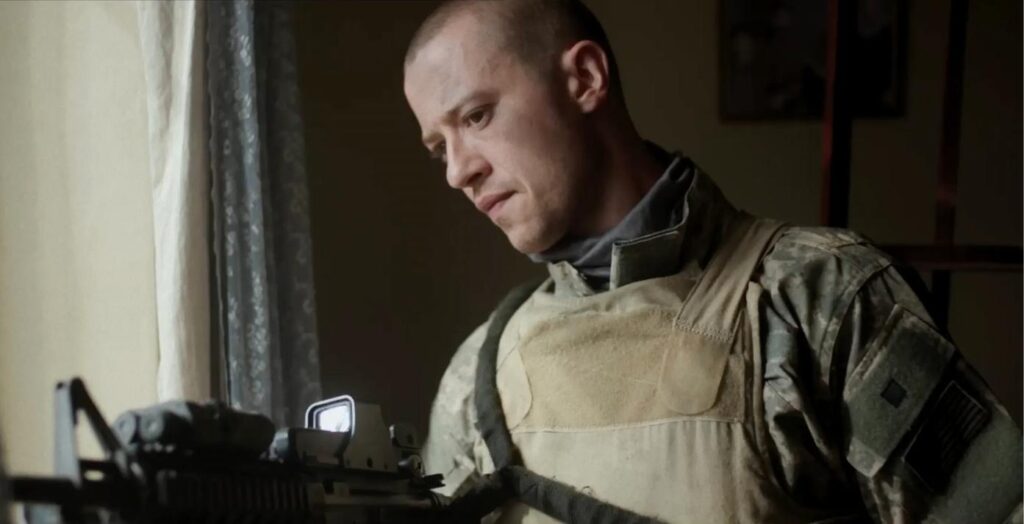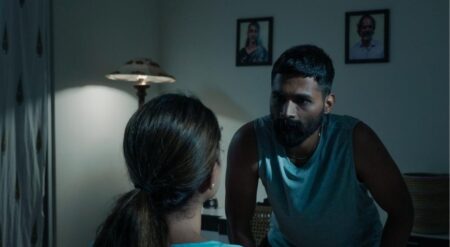Statements of truth in film are as common as they come, especially in a time where every headline or “miraculous” story sells its film right away. In war movies, it’s even more pervasive; each new year in Hollywood, a “little-known” war story gets adapted to correct history. But where does memory stand? Warfare (2025) is Alex Garland‘s latest A24 venture, only this time he’s co-directing and co-writing with Navy Seal-turned-action consultant Ray Mendoza.
Warfare (2025) works to embed its audiences with Ray’s (D’Pharaoh Woon-A-Tai) platoon of American Navy SEALs in the home of an Iraqi family, overwatching the movement of US forces through insurgent territory. With others stationed far enough away to make rescue difficult but close enough to fulfill the mission, as fighting breaks out between the SEALs and the insurgents, hope stands as a thin string as everything worsens.
The film uses Mendoza’s memory to create its script, sound, and everything else. But more importantly, to the film’s tension and pace, it’s done in real-time. Warfare (2025) is a tight 95 minutes on paper, but in IMAX, with the sound booming and the tension rising, it feels like an eternity (but not in a bad way).
A24 and Alex Garland once again deliver some of the best sound design in cinema.

The best part of Civil War (2024), Mendoza and Garland’s first filmmaking foray together, is the best part of this film. Warfare’s soundscapes are jarring and emotive; everything is loud, but every decibel has a purpose. With memory as the guiding thread through the film, we hear the world as Ray hears it, the chaos and fear mingling in adrenaline to ramp up narrative tension.
In one moment, after an IED explodes and casualties and injuries become a reality, we hear through Ray’s shell-shocked ears. A tinnitus ringing muffles the screams of his fellow soldiers, his brothers. You can hear the visceral nature of the screams rising under the suffocating ringing, and then they aren’t muffled anymore. The scream is high and painful, and there is no delay in hearing it. It’s a moment that pushed me back in my seat. The gunfire and explosions are one thing, but the screams are another.
As they try to dress wounds and realize where they are, Ray’s radio doesn’t stop. He hears everyone in his ears in overlapping chatter. Again, it’s blocking out the pain around him, and then he unplugs, and it rises again. Warfare (2025) is a testament to painting soundscapes of emotions, using each piece of the world to showcase the rising exhaustion and trauma as it builds.
Where the sound immerses the audience, the cast pushes the story. Something must be said about the individual resolving into the whole once you enter the military. That’s a difficult task for a cast recognizable as Will Poulter, D’Pharaoh Woon-A-Tai, Cosmo Jarvis, Kit Connor, Finn Bennett, Taylor John Smith, Michael Gandolfini, Adain Bradley, Noah Centineo, Evan Holtzman, Alex Brockdorff, Henrique Zaga, with Joseph Quinn, and Charles Melton. And even with a stacked cast of recognizable actors, each disappears into their roles and each other.

In particular, D’Pharaoh Woon-A-Tai as Ray, Will Poulter as Erik, Joseph Quinn as Sam, and Kit Connor as Tommy deliver jaw-dropping and deeply vulnerable performances. Warfare (2025) is about an extraction, what those men left in that house, and what Ray Mendoza is trying to bring back to them by putting it on film. Every time another grenade goes off, another bullet is fired, and they start to lose a bit of themselves in different ways.
Each of these roles is far detached from what we usually see them in. Poulter is a long way away from comedy, Connor isn’t in a teen romance, Woon-A-Tai is no longer coming of age, and Quinn is completely away from the MCU. These are performances that allow the actors to break their molds, and it works.
Poulter’s character, the unit’s Captain, starts as forceful and in charge. As the fight grows more dire, he begins to break and lose his footing, struggling to stay above water or even think. For Woon-A-Tai and Connor, much of their time on screen before the fight begins makes them look like children with guns. Yes, they’re Navy SEALs, but they’re also just boys in tactical gear waiting for war, that youthfulness is what we see leave them frame by frame. And for Quinn, well, you’ll have to watch.
Warfare (2025) does a lot to put war on film. From one point of view, yes, but the increasing fear that Ray begins to see the world through, moving from machismo bravado to scared boys whose youthful faces are dirtied and haggard, is what sets the film’s tone. It’s this traumatic atmosphere that keeps pressure on your throat and makes you pull back when something unexpected happens.
Ray Mendoza and Alex Garland approach the film with a jarring intimacy that is only possible because of how they chose to tell the story. Within the context of the press tour and understanding that the only pieces of this night that made it in were the ones that Mendoza and the others in his unit who volunteered to be a part of the project could remember, makes all of it feel like something we shouldn’t be watching.
The script doesn’t hide any mistakes the men made. It doesn’t sand off rough edges and it doesn’t show the uniformity that audiences have come to expect from the military on film. The pain is what’s the focus, the avoidable mistakes are painted clearly, the adrenaline of the saviors walking over the wounded is painted just as negatively as it should be. But most interestingly, as the men start to break down from their experience and their mistakes mount, their individuality begins to come through. This is truly Navy SEALs like you’ve never seen them before, and that’s as human.
Warfare’s singular and large flaw is everything that happens once it ends.

In reality, Mendoza, as much as this movie is being shown to audiences in IMAX, intended for this project to reach one person, Elliot. Featured in the film, he remembers nothing of that night. It informs the dedication card that reads “For Elliot,” the slideshow of each man alongside the actor who played them, and the behind-the-scenes footage is included. Those moments are meant to be personal, but for a film as atmospherically dense with pain, the credits feel so incredibly inconsistent with the time we just spent in our theater seats that it undoes the impact left by the film’s choice just to end.
In its credits, Warfare (2025) moves from a take on war that doesn’t sanitize or valorize the actions of the young men in Iraq but instead captures their trauma to an ordinary war flick. All it’s missing is the individual “where are they now” sentences that tell the audience the whole story after what we saw on film. It’s a frustrating development, but one that takes that jarring intimacy down a different and less moving path.
To end here feels like a disservice to the intensity that the audience sits through and lifts up the weight of the war they just watched. It is a frustrating choice that also leaves the lack of direct message in a harsher limbo and removes the boldness of everything before the dedication card.
Warfare (2025) is one memory and expertly directed, with excruciatingly impactful sound and emotive performances. It’s a gripping film that captures the fear and loss of innocence, and yet, that’s only one side of the conflict, and everything after the dedication brings that home. What’s featured in the credits removes the sentiment and reduces the movie to spectacle.
Warfare (2025) will release in theaters from A24 on April 11, 2025.
Warfare (2025)
-
Rating - 7.5/107.5/10
TL;DR
Warfare (2025) is one memory and expertly directed, with excruciatingly impactful sound and emotive performances. Sadly, what’s featured in the credits removes the sentiment and reduces the movie to spectacle.








